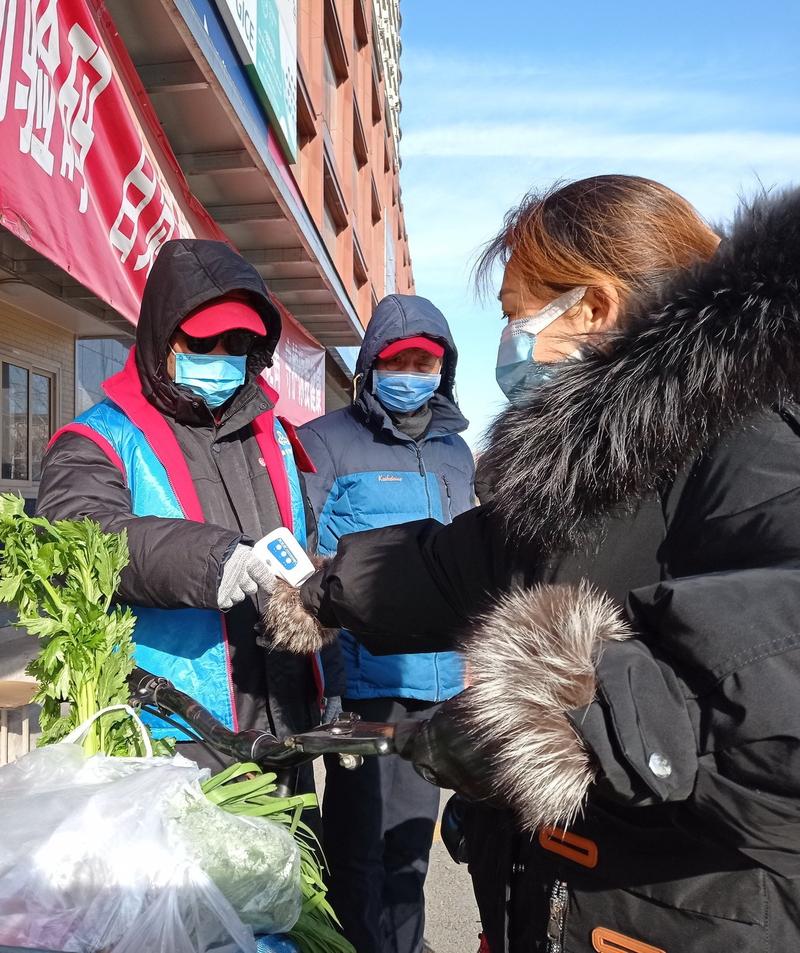 Volunteers check a resident's body temperature at a community in Beijing's Shunyi district on Dec 29, 2020. (WU YIBIN / CHINA DAILY)
Volunteers check a resident's body temperature at a community in Beijing's Shunyi district on Dec 29, 2020. (WU YIBIN / CHINA DAILY)
Intensified COVID-19 prevention and control efforts will be made across China to minimize epidemic risks during the peak travel season, officials said on Wednesday.
More people are expected to travel during holidays and the deteriorating global pandemic situation is making COVID-19 prevention and control more challenging in China, with a sharp rise in the number of cases reported in the country over the past month, Hu Qiangqiang, a spokesman for the National Health Commission, said at a news conference in Beijing on Wednesday.
More people are expected to travel during holidays and the deteriorating global pandemic situation is making COVID-19 prevention and control more challenging in China, with a sharp rise in the number of cases reported in the country over the past month
Although China has basically brought COVID-19 under control, sustained and intensified efforts are needed to carry out various disease control and prevention measures to minimize risks during the New Year's Day holiday, which starts on Friday, and the Spring Festival holiday in mid-February, he said, adding that local officials will be held responsible if they fail in their epidemic control and prevention duties.
READ MORE: Virus: 7 local cases among mainland's 24 fresh infections
Wang Xiuchun, deputy head of transport services at the Ministry of Transport, said it has formulated detailed plans to prevent and control COVID-19 during the annual travel peak surrounding Spring Festival. All front-line transport workers will be asked to strictly follow epidemic prevention and control measures, including wearing masks and gloves, frequently checking body temperature and receiving COVID-19 vaccines voluntarily, he said.
Zhu Wenzhong, from State-owned China Railway, said railway authorities will intensify epidemic prevention control and prevention measures such as train ventilation and sterilization and reserving isolation seats for passengers with fever. An estimated 407 million passenger trips by train will be taken during the 40-day peak travel period, he said.
Liu Kezhi, head of market supervision at the Ministry of Culture and Tourism, said outbound tours organized by travel agencies will continue to be banned during the two holidays, and existing measures such as limiting the number of tourists at scenic spots to 75 percent of capacity will continue.
The authorities made the preparations amid increasing risks of COVID-19 transmission in China. A total of 104 confirmed domestically transmitted COVID-19 cases were reported from Dec 1 to 29, up from about 60 cases all of last month, the National Health Commission said.
Twenty-four confirmed cases were reported on the Chinese mainland on Tuesday, including seven locally transmitted ones, the commission said.
ALSO READ: Mainland sees 15 local cases among 27 fresh virus infections
Despite increased risks with the arrival of the peak travel season, there is little chance of the mainland witnessing another wave of mass outbreaks of COVID-19 in the coming months and there is no need to ban travel during the Spring Festival holiday, said Zhong Nanshan, a prominent expert in respiratory diseases and a member of the Chinese Academy of Engineering. China has formed very effective and strict preventive mechanisms and has introduced concrete and effective measures to prevent and control the spread of the coronavirus in local communities, he said.
On Wednesday, Beijing's Center for Disease Control and Prevention said the recent cluster of novel coronavirus cases in the capital's Shunyi district started with an imported asymptomatic case from Indonesia, based on an epidemiological investigation and genomic sequencing.
"The investigation of the virus samples from the cases and environment showed that the virus is not genetically related to local cases in past months, nor from the United Kingdom or South Africa," Pang Xinghuo, deputy head of the center, said. "It's highly related to a virus discovered in cases in Southeast Asia in November."
Pang said the source was a 28-year-old Indonesian man who arrived in Fujian province on Nov 26, spent 14 days in quarantine, and then arrived in Beijing on Dec 10. He was a close contact of an imported confirmed case who had been a passenger on the same flight to Fujian.
Beijing CDC said 16 cases had been reported in Shunyi district from Dec 23 to Tuesday, which could all be traced back to the Indonesian source. The Indonesian man tested negative in mass testing in the district on Dec 26 but environmental samples around him tested positive. He tested positive on Dec 28.
Shenyang, capital of Liaoning province, tightened its COVID-19 prevention and control measures on Wednesday following new reports of local infections.
The city has expanded nucleic acid testing to all people in medium-risk areas, and high-risk groups will be tested every 48 hours, said Wang Ping, deputy director of the city's disease control and prevention center.
The province reported five confirmed COVID-19 cases on Tuesday, all locally transmitted, with two of them in Shenyang. The city also reported an asymptomatic carrier.
Dalian, a port city in Liaoning, reported three local COVID-19 cases on Tuesday. It classified another four areas as medium-risk COVID-19 zones on Wednesday, local health authorities told a news briefing. The city now has 16 medium-risk COVID-19 areas.
Zheng Caixiong and Xinhua contributed to this story.


